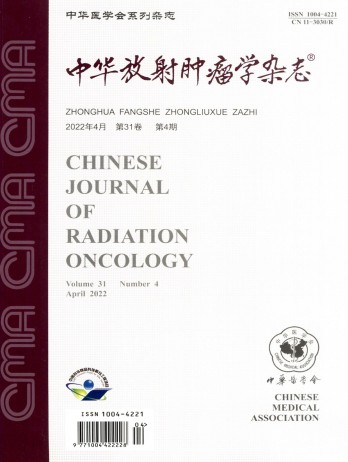Dosimetric comparison between non-coplanar volumetric modulated arc therapy using flattening filter and flattening filter-free beams during stereotactic radiosurgery for brain tumors
引用次数: 0
Abstract
Objective To compare relevant dosimetric parameters of non-coplanar volumetric modulated arc therapy (VMAT) in treating brain tumors in conventional flattening filter (FF) or flattening filter-free (FFF) delivery mode, aiming to explore the appropriate evaluation method of accelerator for stereotactic radiosurgery (SRS). Methods Clinical data of 10 patients with single cranial tumor were retrospectively analyzed. All patients received non-coplanar VMAT at a prescription dose of 25 Gy in 1 fraction. Dosimetric parameters including conformity index (CI), heterogeneity index (HI), gradient index (GI50, GI25), gradient, volume of the brain tissue receiving larger than 10 Gy and 12 Gy(V10 and V12) and beam-on time were statistically compared between two treatment plans by paired sample t-test. Results When FFF-VMAT was compared with FF-VMAT in SRS for intracranial tumors, Paddick gradient index GI50 was 2.91±0.34 vs.3.07±0.35, 6.91±0.28 vs.7.35±0.27 for GI25, (0.57±0.07) cm vs.(0.61±0.08) cm for gradient, respectively (all P 0.05). For the normal brain tissues, the average dose was (160.64±43.64) cGy vs.(174.27±53.98) cGy, (45.35±30.32)% vs.(48.37±30.88)% for V10 and (36.69±25.15)% vs.(39.48±25.37)% for V12, respectively (all P<0.05). Conclusions Non-coplanar VMAT in FFF delivery mode can improve dose distribution and normal brain tissue sparing in the treatment of intracranial single tumors. Meanwhile, supplement of GI index and gradient index can implement comprehensive evaluation of the SRS planning. Key words: Brain neoplasm/stereotactic radiosurgery; Flattening filter-free beam; Dosimetry在脑肿瘤立体定向放射外科治疗中,使用平坦滤光片和不使用平坦滤光片的非共面体积调制电弧治疗的剂量学比较
目的比较非共面体积调制电弧疗法(VMAT)在常规平坦滤波器(FF)和无平坦滤波器(FFF)两种给药模式下治疗脑肿瘤的相关剂量学参数,以探索合适的立体定向放射外科加速器评价方法。方法回顾性分析10例颅内单个肿瘤的临床资料。所有患者均接受非共面VMAT,处方剂量为25Gy,分为1组。通过配对样本t检验,统计比较两种治疗方案的剂量参数,包括一致性指数(CI)、异质性指数(HI)、梯度指数(GI50、GI25)、梯度、接受大于10Gy和12Gy的脑组织体积(V10和V12)和束流通时。结果FFF-VMAT与FF-VMAT在颅内肿瘤SRS中的比较,GI25的Paddick梯度指数GI50分别为2.91±0.34 vs.3.07±0.35、6.91±0.28 vs.7.35±0.27、(0.57±0.07)cm vs.(0.61±0.08)cm(P均0.05)。正常脑组织的平均剂量为(160.64±43.64)cGyvs.(174.27±53.98)cGy,V10和V12分别为(45.35±30.32)%和(48.37±30.88)%,V12为(36.69±25.15)%与(39.48±25.37)%(P均<0.05)。同时,补充GI指数和梯度指数可以实现SRS规划的综合评价。关键词:脑肿瘤/立体定向放射外科;使无滤波器光束变平;剂量测定法
本文章由计算机程序翻译,如有差异,请以英文原文为准。
求助全文
约1分钟内获得全文
求助全文
来源期刊
自引率
0.00%
发文量
6375
期刊介绍:
The Chinese Journal of Radiation Oncology is a national academic journal sponsored by the Chinese Medical Association. It was founded in 1992 and the title was written by Chen Minzhang, the former Minister of Health. Its predecessor was the Chinese Journal of Radiation Oncology, which was founded in 1987. The journal is an authoritative journal in the field of radiation oncology in my country. It focuses on clinical tumor radiotherapy, tumor radiation physics, tumor radiation biology, and thermal therapy. Its main readers are middle and senior clinical doctors and scientific researchers. It is now a monthly journal with a large 16-page format and 80 pages of text. For many years, it has adhered to the principle of combining theory with practice and combining improvement with popularization. It now has columns such as monographs, head and neck tumors (monographs), chest tumors (monographs), abdominal tumors (monographs), physics, technology, biology (monographs), reviews, and investigations and research.

 求助内容:
求助内容: 应助结果提醒方式:
应助结果提醒方式:


